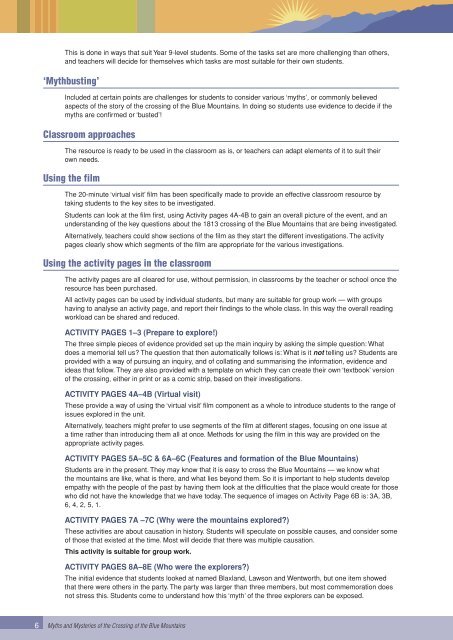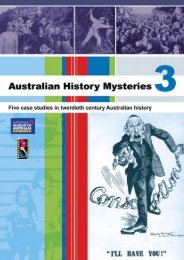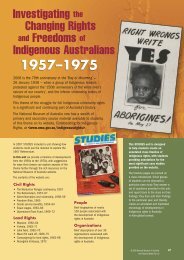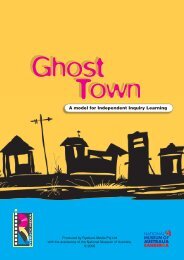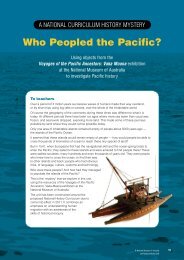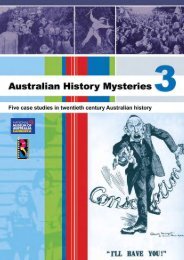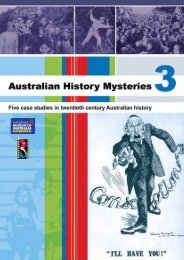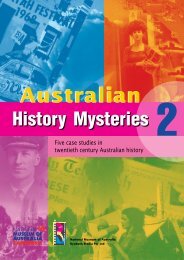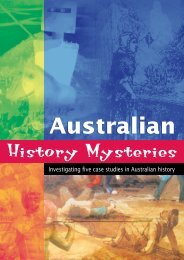Download Teacher Guide & Print Resources - Australian History ...
Download Teacher Guide & Print Resources - Australian History ...
Download Teacher Guide & Print Resources - Australian History ...
You also want an ePaper? Increase the reach of your titles
YUMPU automatically turns print PDFs into web optimized ePapers that Google loves.
This is done in ways that suit Year 9-level students. Some of the tasks set are more challenging than others,<br />
and teachers will decide for themselves which tasks are most suitable for their own students.<br />
‘Mythbusting’<br />
Included at certain points are challenges for students to consider various ‘myths’, or commonly believed<br />
aspects of the story of the crossing of the Blue Mountains. In doing so students use evidence to decide if the<br />
myths are confirmed or ‘busted’!<br />
Classroom approaches<br />
The resource is ready to be used in the classroom as is, or teachers can adapt elements of it to suit their<br />
own needs.<br />
Using the film<br />
The 20-minute ‘virtual visit’ film has been specifically made to provide an effective classroom resource by<br />
taking students to the key sites to be investigated.<br />
Students can look at the film first, using Activity pages 4A-4B to gain an overall picture of the event, and an<br />
understanding of the key questions about the 1813 crossing of the Blue Mountains that are being investigated.<br />
Alternatively, teachers could show sections of the film as they start the different investigations. The activity<br />
pages clearly show which segments of the film are appropriate for the various investigations.<br />
Using the activity pages in the classroom<br />
The activity pages are all cleared for use, without permission, in classrooms by the teacher or school once the<br />
resource has been purchased.<br />
All activity pages can be used by individual students, but many are suitable for group work — with groups<br />
having to analyse an activity page, and report their findings to the whole class. In this way the overall reading<br />
workload can be shared and reduced.<br />
Activity pages 1–3 (Prepare to explore!)<br />
The three simple pieces of evidence provided set up the main inquiry by asking the simple question: What<br />
does a memorial tell us? The question that then automatically follows is: What is it not telling us? Students are<br />
provided with a way of pursuing an inquiry, and of collating and summarising the information, evidence and<br />
ideas that follow. They are also provided with a template on which they can create their own ‘textbook’ version<br />
of the crossing, either in print or as a comic strip, based on their investigations.<br />
Activity pages 4A–4B (Virtual visit)<br />
These provide a way of using the ‘virtual visit’ film component as a whole to introduce students to the range of<br />
issues explored in the unit.<br />
Alternatively, teachers might prefer to use segments of the film at different stages, focusing on one issue at<br />
a time rather than introducing them all at once. Methods for using the film in this way are provided on the<br />
appropriate activity pages.<br />
Activity pages 5A–5C & 6A–6C (Features and formation of the Blue Mountains)<br />
Students are in the present. They may know that it is easy to cross the Blue Mountains — we know what<br />
the mountains are like, what is there, and what lies beyond them. So it is important to help students develop<br />
empathy with the people of the past by having them look at the difficulties that the place would create for those<br />
who did not have the knowledge that we have today. The sequence of images on Activity Page 6B is: 3A, 3B,<br />
6, 4, 2, 5, 1.<br />
Activity pages 7A –7C (Why were the mountains explored?)<br />
These activities are about causation in history. Students will speculate on possible causes, and consider some<br />
of those that existed at the time. Most will decide that there was multiple causation.<br />
This activity is suitable for group work.<br />
Activity pages 8A–8E (Who were the explorers?)<br />
The initial evidence that students looked at named Blaxland, Lawson and Wentworth, but one item showed<br />
that there were others in the party. The party was larger than three members, but most commemoration does<br />
not stress this. Students come to understand how this ‘myth’ of the three explorers can be exposed.<br />
6<br />
Myths and Mysteries of the Crossing of the Blue Mountains


